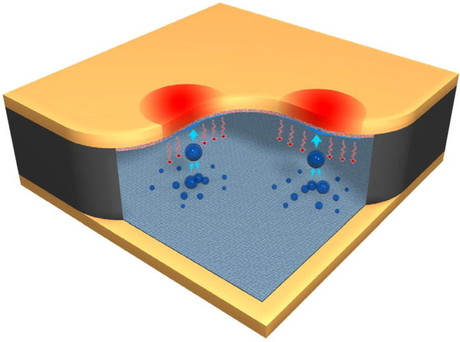Jumping droplets cool mobile hotspots

US researchers have reported a technique designed to address mobile hotspots, which come about through electronic devices’ inability to evenly dissipate the waste heat they produce.
While a few options for hotspot cooling do exist, they don’t work well for mobile hotspots, which move according to ever-changing computing tasks or power-amplification demands.
“Thermoelectric cooling, for example, is best for a fixed hotspot location,” said Chuan-Hua Chen. “And electrowetting requires external power input.”
The new technique was discovered by Chen’s group at Duke University, who found that when two water droplets merge together on a water-repellent (superhydrophobic) surface, the merged droplet spontaneously jumps perpendicular to that surface. They further established that the out-of-plane jumping motion is driven by surface energy initially stored on the droplets and released upon drop coalescence. This effect, which they demonstrated in a vapour chamber, can locally cool hotspots.
The jumping droplet vapour chamber consists of two parallel plates: a superhydrophobic surface and a sponge-like (superhydrophilic) surface. As explained by Chen, “When a hotspot appears on the superhydrophilic surface saturated with water, it drives the working fluid to vaporise. The water vapour condenses on the opposing superhydrophobic surface and rejects the waste heat.
“As condensate droplets grow and merge, the coalescence-induced jumping motion returns the working fluid back to the superhydrophilic surface. This ‘jumping return’ enables continuous operation of the vapour chamber to dissipate heat.”
The main advantage of the jumping droplet technique, published in the journal Applied Physics Letters, is “its mechanism to perpendicularly return the working fluid to the hotspots”, said Chen. “And because jumping droplets are driven by intrinsic surface energy, the technique is independent of external forces and gravitational orientation.”
Another advantage is that the jumping droplet technique cools mobile hotspots without any active power input, similarly to flat-plate heat pipes, which remove heat through horizontal spreading. This method is much more effective than high thermal conductivity copper or even diamond heat sinks, but still lacks a vertical mechanism to dissipate heat.
“Our technique not only retains the high effectiveness of flat-plate heat pipes for in-plane heat spreading, but also provides a much better capability for out-of-plane heat transport because of the perpendicular jumping mechanism,” Chen said.
The combination of horizontal and vertical spreading is ideal for heat dissipation, with Chen analogising, “To avoid flooding, it’s useful to spread the rain horizontally over a large area. But if the ground becomes soaked and water has no vertical pathway to escape, flooding is inevitable. Our jumping droplet technology addresses this technological void with a vertical heat spreading mechanism, opening the door to outperforming the best solid heat spreaders in all directions.”
Because the performance of computers and power electronics depends so heavily on their ability to dispose of heat waste, the new method could enable faster computing and longer lifetimes for electronics. Going forward, the researchers are looking at material choices to best exploit their new technique.
“It’s technically challenging to design a jumping droplet vapour chamber with materials of opposite wettability that are compatible with high-temperature vapour,” said Chen. “We’ll fine-tune material choices so that our system can stably work at higher temperature with more effective heat dissipation. We’ve already demonstrated a cooling performance comparable to copper, but I see a pathway to significantly exceed this industrial standard once we sort out the material issue.”
Researchers create quantum 'Schrödinger's cat' in silicon chip
Researchers have brought a famous quantum thought experiment, ‘Schrödinger’s...
Quantum teleportation performed over busy internet cables
Northwestern engineers have demonstrated quantum teleportation over a fibre-optic cable carrying...
Nanoscale transistors could enable more efficient electronics
Researchers are leveraging quantum mechanical properties to overcome the limits of silicon...




